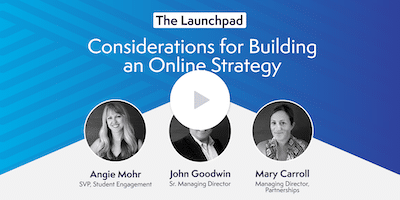Data is an enrollment marketer’s number one weapon. According to Forbes, “companies who adopt data-driven marketing are more likely to have an advantage over the competition and…they are six times more likely to be profitable year over year.” It’s no surprise, then, that universities continue to increase their marketing investment year over year. According to Educational Marketing Group, public and private nonprofit institutions typically spend anywhere from 1.5–6.0 percent of the institution’s annual operating budget on marketing. (In 2010, that range was 1.0–4.0 percent). With so many marketing choices to make in today’s digital landscape, it’s tough to know how to put your data to work in the most effective ways possible. Utilizing the right portfolio of techniques in the best performing channels is critical for making sure your marketing dollars are working smarter. Here are five proven ways to ensure you are using your data to help your institution grow enrollment effectively and responsibly.
Use 1st Party Data

Data privacy is increasingly important to consumers. In the wake of Facebook’s Cambridge Analytica scandal and enforcement of The General Data Protection Regulation (GDPR), using
While not all
But first party data has benefits outside of privacy considerations. First party data is exclusive: you own it, will have access to it forever, and know for sure that no other advertiser is using it to reach potential students. You can’t say the same about third-party data! Even better, first-party data is cheaper. With third-party data, CPMs typically run much higher because you are paying a premium for that data provider. With first-party data, you cut those costs entirely.
Ensure Your Data Is Accurate
Accurate data is the foundation for all successful marketing and advertising tactics. In fact, making business decisions based
1. Make sure everyone is speaking the same language.
Especially if you are working with multiple marketing agencies or team members, it is essential that all channels are leveraging the same parameters. For example, if your agency labels Facebook ad buys as “Paid Social” and your in-house specialist tags it “Facebook,” you now have two different channels where there is really only one. To do this, build a data key or library that specifically defines how each channel, source, and
2. Prioritize what data to track.
Students engage with content across all channels with the expectation that you are tracking them and will
3. Ensure privacy and compliance when collecting data.
When collecting your own data, it is essential that the potential student is aware that their data is being collected and understands what purpose you are using it for. Here is a great example of compliant language:
By using compliant language, you are not only ensuring user
Monitor The Whole Funnel

You may be successfully driving cost-effective inquiries, but are those translating into your ultimate goal of growing application, enrollment, or start numbers? To know this, it is essential to have properly tracked data. Then you can monitor the whole funnel, allowing you to track a prospective student back to their original source and see where you have conversion successes or roadblocks along the way.
Once you are able to track data through the whole funnel, stop to examine it at least once per quarter. Use previously established benchmarks, different for each channel source, of what is an acceptable cost-per-acquisition, enrollment rate, or
As we’ve already said, personalization is key to any effective marketing strategy, so ensuring that you are speaking to your students at the right place and the right time is mandatory. By monitoring the whole funnel, you can use your tracking to create a drip campaign that sends a student appropriate messaging based on where they are in the decision-making process. Then you will know for sure that you are shaping the right message and serving the right people!
Leverage Lookalikes

One of the most potentially impactful methods of leveraging your first-party data is to create lookalike audiences of students who are likely to be a good match for your school because they resemble your existing target audience data. It allows advertisers to create lookalike audiences from CRM data, website traffic behavior, app activity, and even from people who have recently engaged with your school’s Facebook or Instagram profiles. Facebook’s lookalike audience feature has been around for over 5 years and continues to improve.
At Archer, we have exclusive, first-party data on more than 2.3 million prospective students that we utilize to make lookalike audiences solely for our clients. We have been able to help schools improve their conversion rates up to 37% (while decreasing conversion costs) utilizing Lookalike Audiences vs. Facebook’s “interest” parameters alone.

Don’t Set It And Forget It

This is true for all marketing strategies, but with lookalike audiences it is especially crucial that you never stop testing for the best formula. Continually refining your audience will ensure you have the narrow approach which creates the personalized marketing experiences that drives results.
Begin by prioritizing based on what you think works best, and continue testing from there. For example, you can start with who Facebook suggests looks like your first party data and segment based on its stage in the funnel or the program of interest. To take it to the next level, you can start A/B testing other layers of data, like estimated start date or zip code, to hone in on what attributes perform the best. Then you can see what works best at each stage of the funnel, ensuring you are putting every piece of data to work
WIth an infinite amount of targeting combinations, testing is also an infinite possibility. As long as you are picking out major unique elements to test that may move the needle, you can continue to find what blend of data will work the best for you.
By following the these five tips, you will be setting up a foundation for enrollment marketing success with proper tracking and clean data – which leads to better visibility into what is effective and more informed decision-making.
We are here to help you manage your enrollment marketing efforts as a strategic marketing partner. Want to learn more? Contact us to speak to one of our enrollment marketing experts or sign up for a free digital marketing assessment to learn how we can help your institution reach further, recruit smarter, and grow faster.



